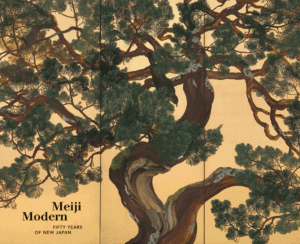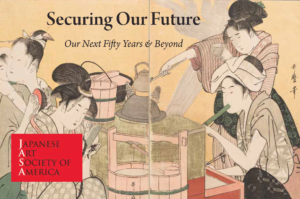 The Japanese Art Society of America (JASA) promotes the study and appreciation of Japanese art. Founded in 1973 as the Ukiyo-e Society of America by collectors of Japanese prints, JASA’s mission has expanded to include related fields of Japanese art. Through its annual lectures, seminars and other events, the Society provides a dynamic forum in which members can exchange ideas and experiences with experts about traditional and contemporary arts of Japan.
The Japanese Art Society of America (JASA) promotes the study and appreciation of Japanese art. Founded in 1973 as the Ukiyo-e Society of America by collectors of Japanese prints, JASA’s mission has expanded to include related fields of Japanese art. Through its annual lectures, seminars and other events, the Society provides a dynamic forum in which members can exchange ideas and experiences with experts about traditional and contemporary arts of Japan.
Help Us Celebrate 50 Years of JASA!

After a highly successful run at the Asia Society Museum in New York last year and the Smart Museum of Art at the University of Chicago in the spring, JASA’s 50th anniversary exhibition, Meiji Modern: Fifty Years of New Japan, will be view at The Museum of Fine Arts, Houston, from July 7 through September 15. Learn more about it at the MFAH’s website. One review called Meiji Modern a “perfect exhibition,” engaging both scholars and non-specialist visitors who are “thrilled to discover beautiful art they didn’t know and to learn its history in labels that are both clear and serious.”
JASA’s beautiful 272-page full-color catalog for the exhibition (cover above) takes a fresh look at the art of the Meiji period (1868-1912) through approximately 200 objects drawn from public and private collections across the United States, including newly discovered prints, photographs, textiles, paintings and craft objects. Copies of the catalog can be ordered through the JASA Store or our mail-in Publications Order Form.
 JASA has embarked on a major capital campaign. Our goal is to raise a total of $2.5 million to help secure our future as the premier membership organization in North America dedicated to the arts and culture of Japan. Thanks to the generosity of our members and supporters, we already have raised nearly one-third of this amount to fund the Meiji Modern exhibition. Won’t you help us secure the remaining $1.7 million, to support Impressions, scholarship in Japanese art history, and JASA programming? Download our Securing Our Future brochure here and watch the video here to learn more about this important initiative and how you can be part of building JASA’s exciting future!
JASA has embarked on a major capital campaign. Our goal is to raise a total of $2.5 million to help secure our future as the premier membership organization in North America dedicated to the arts and culture of Japan. Thanks to the generosity of our members and supporters, we already have raised nearly one-third of this amount to fund the Meiji Modern exhibition. Won’t you help us secure the remaining $1.7 million, to support Impressions, scholarship in Japanese art history, and JASA programming? Download our Securing Our Future brochure here and watch the video here to learn more about this important initiative and how you can be part of building JASA’s exciting future!
June JASA Events

Join us on Thursday, June 13, at 5 p.m. EDT, for the Zoom webinar Exceptional Japanese Houses: Residential Design From 1945 to the Present. Architect and journalist Naomi Pollock will discuss her new book, The Japanese House Since 1945. Spanning eight decades, this book presents the most compelling examples and highlights key developments in form, organization, material, architectural expression and family living. Click here to register: June 13 zoom webinar.
On Thursday, June 20, 12 p.m. EDT, JASA members can take a special in-person tour of the exhibition Toshiko Takaezu: World’s Within at The Noguchi Museum in Long Island City. It features approximately 200 objects from public and private collections across the country, presenting a comprehensive portrait of the life and work of clay artist Takaezu. Sign up by June 13 is required. Click here to register and pay via check or PayPal or Zelle.
Also, June 10 is the deadline to register for our July 12 through 14 trip to Houston to visit three extraordinary Asian art exhibitions. For details of these and upcoming events, visit our JASA-Sponsored Events page.
For those who missed our May 13 Zoom webinar on Hiroshige’s 100 Famous Views of Edo, with Andreas Marks, the video is posted below.
JASA’s 50th anniversary exhibition, Meiji Modern: Fifty Years of New Japan, is on view at the Smart Museum of Art at the University of Chicago from March 21 through June 9. Learn more about it at the Smart Museum of Art website, which also includes a listing of special Meiji-themed events held in conjunction with the exhibition. Visit the site often for updates and additional information.
You can also find links and details for all recorded JASA events on our Lecture Videos page.
- Lecture: Hiroshige’s 100 Famous Views of Edo (Dr. Andreas Marks) May 19, 2024Hiroshige’s 100 Famous Views of Edo (Dr. Andreas Marks)
Our May 3, 2024, webinar was the second JASA program this spring to focus on Utagawa Hiroshige’s One Hundred Famous Views of Edo. Following the Zoom webinar featuring the Brooklyn Museum’s rare set that is currently on exhibition through August 4, 2024, noted curator and author, Dr. Andreas Marks, Mary Griggs Burke Curator of Japanese and Korean Art and Director of the Clark Center at the Minneapolis Institute of Art, discusses his newly published book, Hiroshige’s One Hundred Famous Views of Edo: The Definitive Collector’s Edition. Utagawa Hiroshige’s monumental landscape series, first published in the 1850s, is among the best-known and highly coveted group of Japanese prints. In this series, Hiroshige depicts 118 locations in and around Edo (today’s Tokyo) during the four seasons, often from hitherto obscure and unique perspectives. Hiroshige’s views were so popular that each design was reprinted many times. Some have reached iconic status.
For his study, Dr. Marks reviewed 4,700 prints from the series. Drawn from 32 different museums and private collections, the book is the first to present all deluxe versions printed that incorporate special printing features, such as like color gradation. Dr. Marks reveals that no complete set of the deluxe versions is held in a single collection today. He shows how and where Hiroshige’s ideas for each view originated with reference images, and discusses Hiroshige’s designs through the many later printed versions. With 700 images, the book is a definitive guide to understanding the complexity of Hiroshige’s great work as well as the dynamics of the Japanese print market during this period.
- Lecture: Hiroshige’s 100 Famous Views of Edo April 3, 2024Hiroshige’s 100 Famous Views of Edo
On view from April 5 through August 4, 2024, Brooklyn Museum’s exhibition of Hiroshige’s One Hundred Famous Views of Edo features new versions of the original views by the iconic Japanese artist Takashi Murakami, with photographs by Ȧlex Bueno of some of the contemporary sites of Hiroshige’s designs. This panel discussion, presented live on April 3, 2024, includes catalog author and historian Henry Smith, Professor Emeritus, Columbia University; Joan Cummins, Senior Curator, Asian Art, Brooklyn Museum and exhibition curator; and Ȧlex Bueno, Project Assistant and Professor, Centre for Global Education, Tokyo, who discusses photographic images in the exhibition.
- Lecture: When Zen Becomes Political: Zen and Soft/Hard Power (Dr. Frank Feltens) March 22, 2024When Zen Becomes Political: Zen and Soft/Hard Power (Dr. Frank Feltens)
As part of Asia Week 2024, JASA is presenting a special lecture, When Zen Becomes Political: Zen and Soft/Hard Power, by Frank Feltens, curator of Japanese Art at the Smithsonian’s National Museum of Asian Art. Zen has been used to foster political agendas, as inspiration for activism, and as a way to go against common norms. This talk highlights distinctive moments and individuals that made Zen and its arts a part of the political discourse of their times. They showcase how Zen has been part of Japan’s hard and soft power for centuries and continued to be in the twentieth century.
- Lecture: Surprises in the South: Japanese Art in Alabama (Dr. Katherine Anne Paul) February 7, 2024Surprises in the South: Japanese Art in Alabama (Dr. Katherine Anne Paul)
Did you know there is another JASA? The Japan-American Society of Alabama! This is only one aspect of under-known connections between Japan and the state of Alabama. In this February 7, 2024, webinar Dr. Katherine Anne Paul, Virginia and William Spencer III Curator of Asian Art at the Birmingham Museum of Art in Alabama, discusses the many surprises and connections with Japanese Art in Alabama, including:
- Mobile, Alabama, native, Mary McNeil Fenollosa—co-author of Epochs of Chinese and Japanese Art: An Outline History of East Asiatic Design, with her husband, Ernest Fenollosa—left her collection to the Mobile History Museum.
- In 1915, the town of Satsuma, Alabama, was named after the Japanese satsuma orange, which was successfully cultivated and grown there starting in 1878, a gift from Emperor Meiji.
- Part of the Birmingham Botanical Gardens, a Japanesque garden designed by Japanese-American architect Masaji “Buffy” Murai showcases a Japanese tea house called Toshinan, designed and installed by Kazunori Tago (eighth generation Miyadaiku from Maebashi, Japan).
- Of course, there is also the great work of Dr. Donald A. Wood at the Birmingham Museum of Art (Awardee of the Order of the Rising Sun, Gold and Silver Rays) renowned for his Kamisaka Sekka: Rimpa Master—Pioneer of Modern Design exhibition and publication as well as his work with Echizen ceramics. Throughout his 30 year career Don Wood keenly acquired Japanese works for Birmingham’s collections. Many of these works, like Kasuga Shika Mandala by Rokkaku Jakusai, have fascinating Alabama histories.
- Lecture: Anxiety and Hope in Japanese Art: An Exhibition Talk with Dr. Aaron Rio January 24, 2024Anxiety and Hope in Japanese Art: An Exhibition Talk with Dr. Aaron Rio
In a time of uncertainty around the world, one singular exhibition has captured the essence of how art in Japan has marked times within its history that can offer the viewer new insights and powerful messages of hope and positive views. The show is Anxiety and Hope in Japanese Art, curated by Dr. Aaron Rio, Associate Curator of Japanese Art at The Metropolitan Museum of Art. His talk focuses on the third rotation of four in this year-long exhibition in the Japanese galleries of the museum, made possible by The Miriam and Ira D. Wallach Foundation Fund.
The exhibition begins with sacred images from early Japan that speak to concerns about death, dying, and the afterlife or that were created in response to other uncertainties, such as war and natural disaster. The presentation then proceeds chronologically, highlighting medieval Buddhist images of paradises and hells, Zen responses to life and death, depictions of war and pilgrimage, and the role of protective and hopeful images in everyday life. In the final galleries, the exhibition’s underlying themes are explored through a selection of modern woodblock prints, garments and photographs.
